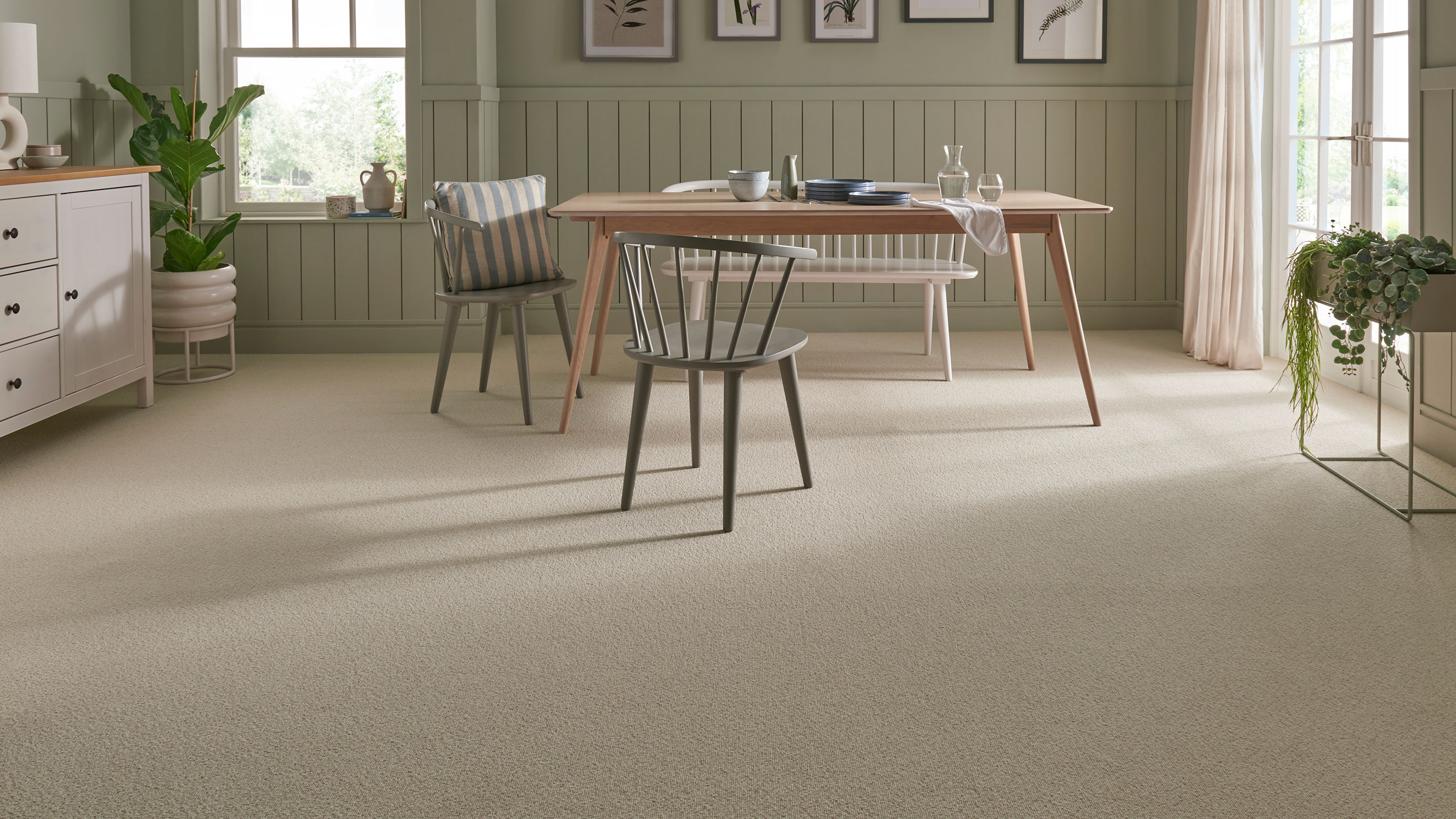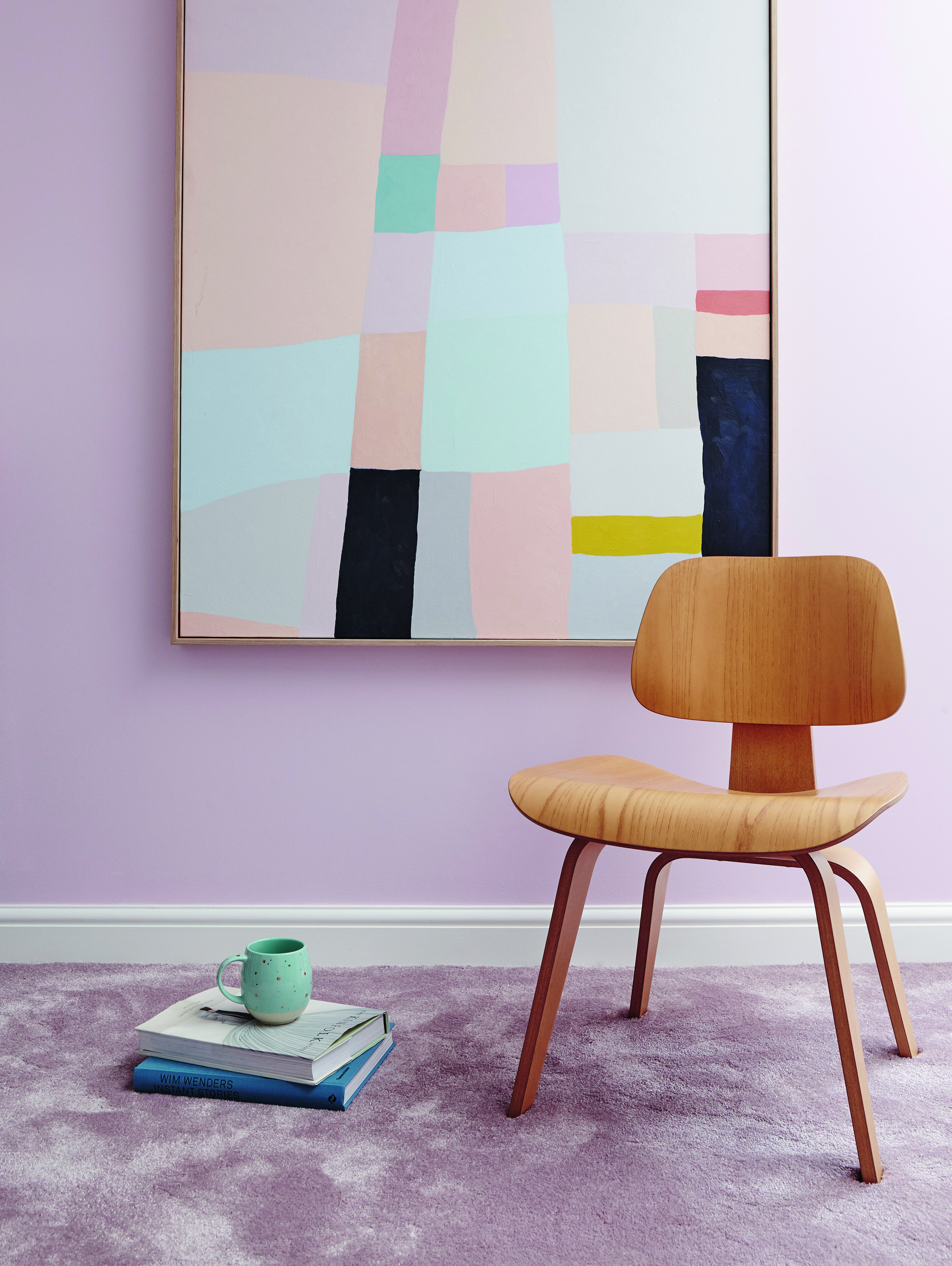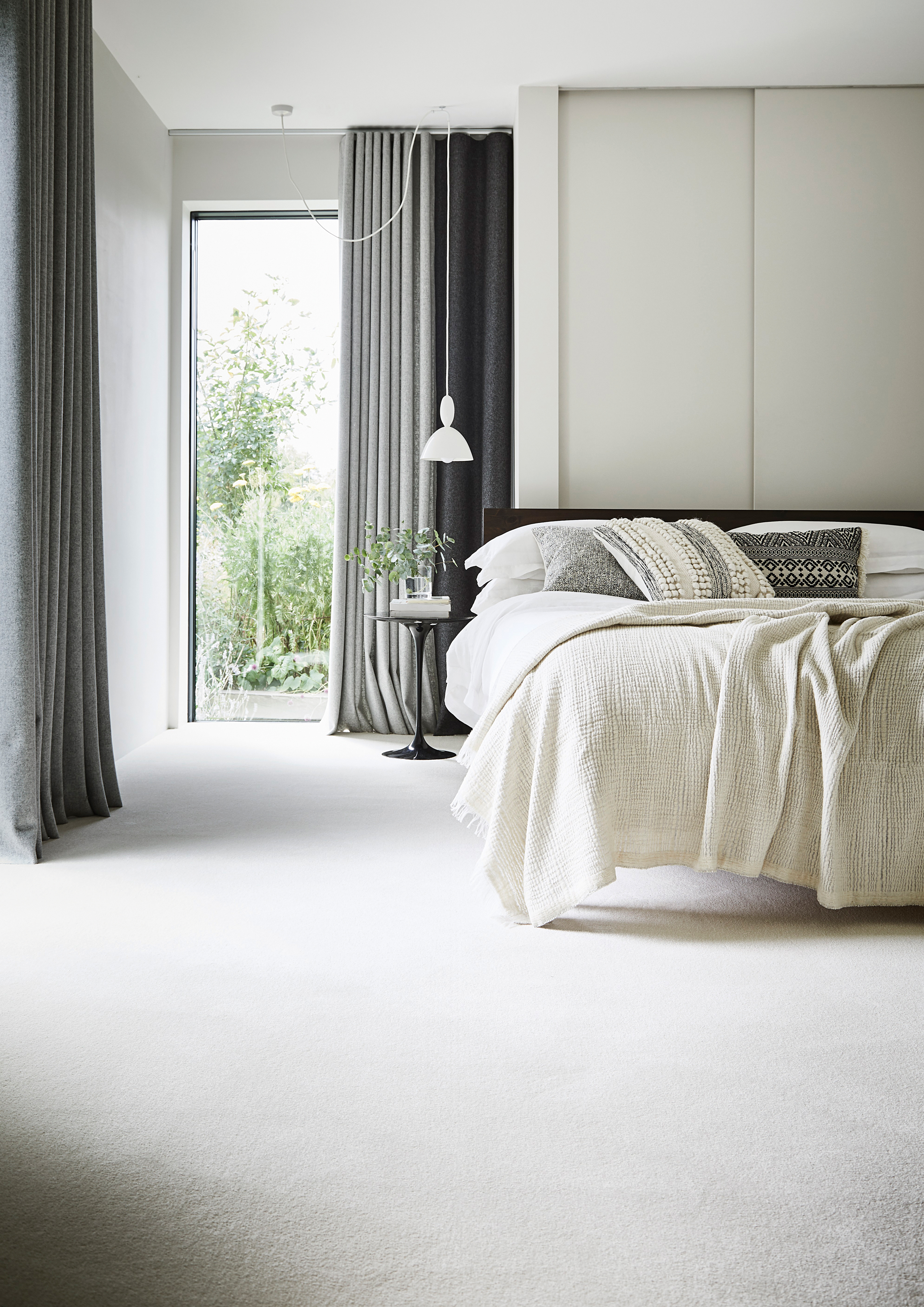Which types of carpet are best suited to your home?
With so many types of carpet available, knowing which will be best for the various areas of your home can be tricky. In this guide, we explain the different products available to help make your decision a little easier

In the world of flooring choices, most types of carpet are still a highly popular option, despite there being so many different types of flooring available.
Although carpet is often shunned in favour of hard flooring materials, such as wood and stone, it has an awful lot to offer homeowners and a high-quality product can last for up to 20 years or even more.
In addition to this, carpet also acts as an excellent heat and sound insulator, plus it feels cosy, comforting and soft underfoot, as well as adding a visual warmth that it can be hard to achieve with some hard flooring materials. And, finally, carpet offers so much in the way of design flexibility, coming in a massive array of colours, patterns and textures.
So, before you rule out carpet on the grounds that you think it won't be hardwearing enough for your needs, or that it might require lots of maintenance, take a look at our guide to all the different types of carpet available.
Choosing from the types of carpet available
If you have ever wandered into a carpet showroom, you will no doubt have felt rather overwhelmed initially — perhaps you thought you had a good grasp on your living room flooring ideas but there are just so many options and many of them look really quite similar.
You are faced with choices on everything from the material the carpet is made from to pile types, patterns, colours and even what underlay will be best. It is for this reason that it really does pay to do your research before even stepping foot in a shop. If you have made decisions on all these options beforehand you will know exactly where to head and what to ask the store assistants for.
Once you’re ready to begin browsing, it’s smart to take some approximate measurements. You may well be asked for these — plus it will help you get a good idea of the kind of costs you might be looking at and help whittle down your choices.
Bring your dream home to life with expert advice, how to guides and design inspiration. Sign up for our newsletter and get two free tickets to a Homebuilding & Renovating Show near you.
Most retailers are happy to provide a selection of swatches free of charge, so you can take them home and double check whether various styles and shades complement your home’s décor. Remember to place each swatch in both the darkest and brightest areas of the room so you can be sure how light affects the colour of the carpet’s surface.

What to consider when choosing carpet
When choosing the best carpet for your home, and the different areas within in, there are several considerations to bear in mind:
- Where is the carpet being laid? The first step is to consider where in your house the carpet is going to be laid and the purpose it’s going to serve. This is a good starting point in determining how durable it needs to be.
- What is your budget? How much you have available to spend will very much affect the type of carpets you should be looking at.
- Do you have pets? Those with four-legged friends will need to consider pile, colour and materials carefully if they want to maintain the good looks of the their carpet.
- What do you want from your carpet? This may sound odd, but if you are just looking for a quick fix and plan on moving in the not too distant future, your needs will be different for those looking to make a long-term investment.
- Who lives in your house? Those with children or anyone a little prone to clumsiness should be looking at types of carpet that are easy to clean (or can hide dirt well...)
- What size is the space you are carpeting? If you are dealing with a very small space you might want to look at carpets that can help make the space look bigger, for example.
- Do you want a natural carpet? If you are keen to avoid chemicals in your home or want to take a more natural approach to your flooring, you will want to focus your search on natural materials, as opposed to synthetic.
Once you have the answers to the above questions, you can begin to research the different materials carpets are most commonly made from and decide which will most suit your needs.

Wool carpets
If you’re keen to fit a carpet made from natural fibres, wool is a great main contender.
This resilient and highly durable material results in a high-quality carpet that will last for years. It’s also sustainable, not to mention the fact that it’s super-soft underfoot and is a good insulating material.
"Wool carpets are a great choice for high traffic areas as they have a natural, in-built resilience in the fibres making them perfect for those after the best carpet for stairs," explains Alexandra Hindle from Cormar Carpets.
They are also a great choice for those after an easy-to-clean option. “The protective, waxy coating on the fibres makes wool products resistant to staining, too,” says Lisa Conway, residential marketing manager at Brintons. “A wool carpet will also pick up less dust as the material is naturally anti-static.”
"For areas that get lots of traffic, a more tightly woven wool such as a boucle is preferable because it can be cleaned easily; or go for a carpet with a fleck in it, which hides a multitude of sins," advises Lorna Haigh, creative director at Alternative Flooring.

Wool blend carpets
Wool blend carpets are, on the whole, a more affordable option than wool, yet they also come with a range of other benefits.
Wool blend carpets are also sometimes referred to as '80/20 wool'. This is because they are usually 80% wool and 20% something else, probably synthetic, such as nylon.
They are highly durable, making them a great option for those after something for high traffic areas of the home, such as entrance halls or stairs.
Synthetic carpets
There are numerous manmade options for your carpet too, all of which tend to be highly stain resistant.
"Some manmade fibres, like nylon 6.6, offer the same benefits as wool carpets but with better cleaning and maintenance properties,” says Gregory Powley-Lynch, operations director at Elements London.
Nylon is a good all-rounder for family homes as it offers good wearability. Polypropylene is another option, as it’s both durable and resistant to stains. “However, it’s not advisable to go for a polypropylene carpet in heavy traffic areas as this will cause flattening very quickly,” advises Gregory.
You also need to be aware than wholly synthetic carpets, particularly those at the cheaper end of the price scale, can lack that luxurious underfoot feel that wool and wool blends offer. In addition, they don't have the same green credentials as natural materials and some give off VOCs. However, it is important to note that manufacturers are now developing greener options, such as nylon carpets made from recycled products.

Natural carpets
If you’re keen to boost your home’s green credentials then do spend some time looking at the natural carpets aside from wool on offer.
Natural fibres such as sisal, coir, jute and seagrass offer an attractive and sustainable alternative. Plus, they contain fewer chemicals than manmade products, as well as offering many other practical benefits to homeowners.
For those after something lovely and soft underfoot, jute tends to be the best option.
"Jute is the softest of the natural floor coverings, giving a comfortable feel underfoot," says Alex Heslop. However, bear in mind that if you want something for a high traffic area, it is not as hardwearing as some other options.
Coir and sisal are great for those after a really hardwearing option, while seagrass offers very good moisture resistance. That said, if you are looking for bathroom flooring, it might be best researching hard flooring materials.
Choosing carpet pile
The term ‘pile’ essentially refers to how the loops or tufts of fibre are attached to the material backing of the carpet. In broad terms, carpet can be divided into two categories: tufted and woven, and there are numerous variations of each. Bear in mind, not all pile types are suitable for every application.
Made by weaving the front and back of the carpet at the same time using traditional looming methods, woven products tend to be more time-consuming to produce and are typically more expensive as a result. However, you’ll get a high-quality finish and a carpet that will hold its appearance well over time. Axminster and Wilton are both examples of woven carpets.
Tufted carpets are less labour intensive to produce, so tend to be cheaper. A row of needles is used to punch the yarn into a backing fabric, before a secondary backing material is applied. Twist products are probably the most popular type of carpet in the tufted category, offering an effective all-round performance. This solution is a good choice for areas of the home with high footfall, like hallways and stairs.
Berber or looped pile products are made from continuous uncut loops on the surface of the carpet, resulting in a distinctive knotted appearance.
For busy areas, choose a Berber carpet with small, tight loops that can bounce back easily. For the bedroom, a Saxony carpet offers an opulent deep pile with long tufts, making for a beautifully soft feeling underfoot. Velvet varieties are also a good choice for the bedroom, thanks to the smooth feel of the cut pile finish.
Those after ideas for the best carpet for pets need to pay particular attention to pile.
“If you have a cat or another pet with sharp claws, your new carpet has the capacity to become the ultimate playground for them. It will more than likely end in tears — for you, not the pet!” says Charles Barraclough, operations director at Wools of Cumbria Carpets. “Cut pile carpets are absolutely fine though. What’s more, they will hold onto moulted fur until you’re ready to vacuum, rather than harder surfaces which let it float around the edges of the room.”
"A loop pile wool carpet can be problematic as its fabric is easily snagged by claws," says Gemma Holsgrove. "A more formal cut pile carpet design is a little difficult to clean when subjected to dirt and damp."
Assessing the durability of carpet is all about the thickness, the material it’s made from and the weight of the pile. One way to test how well the carpet will wear and tear is to press your thumb firmly into the pile. The quicker it springs back and recovers, the more resilient it will be once laid.

How do you measure for carpet?
While it’s handy to visit showrooms with a set of approximate measurements for the room you’re carpeting, it often pays to bring in the experts to measure up before you place your order. For peace of mind when it comes to choosing your retailer, look out for suppliers registered with The Carpet Foundation for an assurance on quality. Fitting the carpet yourself isn’t beyond the realms of possibility if you’re a competent DIYer. However, many retailers will throw in the fitting for free if you spend over a certain amount.
Before your carpet is installed, ensure the subfloor has been adequately prepared. “All subfloors should be as level as possible, and any loose floorboards screwed down — but do check for pipes under floorboards,” says Michael McHugh from M&L Carpets.
Gaps between the floor and skirting should be sealed, too.

What is a carpet's tog rating?
When you buy a carpet it’ll come with a tog rating, just like a duvet. The tog rating is a measure of how much heat can pass through the material, effectively an indication of how insulating it is. Carpet togs range from around 0.7 to 3.0. The higher the tog rating, the more insulating it is. A higher carpet tog would therefore be ideal for a cold, draughty room.
And if you’re laying underfloor heating (UFH), research carried out by The Carpet Foundation and the Underfloor Heating Manufacturers Association showed that most carpets can be used with UFH without hindering the performance of the system.
“The research demonstrated that a carpet/underlay with a combined thermal resistance of less than 2.5 togs allows underfloor systems to operate efficiently,” explains Lisa Conway from Brintons.
Choosing carpet underlay
As well as helping your carpet to sit evenly across the floor surface, underlay adds additional insulation and will help keep heat inside the room. Choosing a good quality product makes all the difference when it comes to the longevity of your carpet, as it will be able to reduce the compression of the carpet and ensure it lasts longer.
“A good quality underlay is very important for comfort and the life of the carpet,” says Charles Barraclough. “It should be comparable in thickness to the carpet over it. Too thin and the carpet will wear quicker, too thick and the carpet is liable to move around.”
There are numerous options for your underlay, which typically fall into one of two material categories: rubber or foam. As with the carpet itself, various underlay specification options are available depending on your budget and the finish you want to achieve. You can pick up a roll of 6mm underlay suitable for use with UFH online for as little as £3.85.
Environmentally friendly underlay options are available, too (check out Springbond). They can be made from recycled carpet waste or plastics.

Caring for your carpet
A good carpet can last for years — providing it is properly maintained and regularly vacuumed. As a rule of thumb, aim to vacuum at least once a week.
“Regularly vacuuming not only helps to prevent unwanted dirt from working its way into the carpet fibres but also helps to keep the tufts of the surface upright, maintaining the soft, brand new look for longer,” says Joanna Ramsden from Grosvenor Wilton.
“Opt for a vacuum cleaner that has brushes or a beater if you have a cut pile carpet. Or, for loop pile products, these should be maintained using a suction only cleaner.”
Don’t be afraid to vacuum the carpet soon after it’s been fitted, either, as new carpets tend to shed fibres once they’ve been laid. Regardless of your carpet’s material or pile, any spillages should be dealt with as soon as possible. “The spillage should be gently mopped and blotted or scooped up with a spoon,” says Joanna. “The carpet should never be rubbed as this can cause the fibres to burst, causing a fuzzy appearance.”
For a deep clean, special carpet shampoos can be used — but always consult your manufacturer’s guidance on cleaning before applying any products to the floor. Some cleaners contain bleach, which isn’t suitable for all materials. For a deep clean with best results, employ a professional carpet cleaning company.

How much does carpet cost?
In terms of carpet costs, prices vary enormously, depending on the material and pile you go for. “Most budget options will see you paying around £10-£25/m2,” says Gregory from Elements London. “For a high quality carpet you’re looking at the £30- £60/m2 mark. This will last you much longer and will actually save you money in the long run.”
Both material and pile will have an effect on cost. Cut and loop carpets tend to be one of the cheaper options, as do loop pile and Berber. At the top end of the price scale lie velvet carpets.
Wool carpets start from £20/m2 although can cost up to over £150/m2. Some synthetic carpets can cost as little as £6/m2, although certain wool blends containing polypropylene cost more than £100/m2. When it comes to natural carpets, expect average starting prices of £18/m2 for jute, coir and seagrass and £25m2 for sisal.
When placing your order for the carpet, double check what is included in the price. Admin fees for extras, such as the removal of old carpet, can be tagged onto your bill so it’s important to factor these in to your overall outlay for new flooring. Also factor in installation.
Rebecca began her journalism career writing for a luxury property magazine in Bangkok, before re-locating to London and becoming a features editor for a self build magazine. She is an experienced homes and interiors journalist and has written for many homes titles including Homebuilding & Renovating, Ideal Home and Period Living.
She has expertise on a wealth of topics — from oak frame homes to kitchen extensions. She has a passion for Victorian architecture; her dream is to extend an 1800s house.

